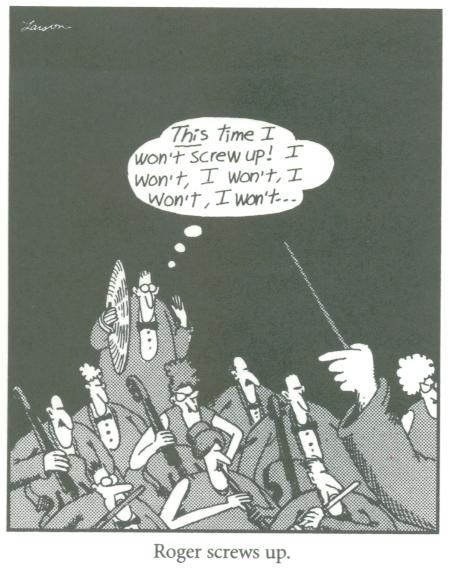Cartoonist Gary Larson’s genius is to reveal life from unusual perspectives. His work turns everyday situations inside out and in doing so, gifts us with both a smile and an insight all at the same time.
One of my favourite Larson depictions is that of an orchestra where the percussionist, standing at the back, hands raised, is poised ready to make his contribution whilst saying to himself, “This time I won’t screw-up. I won’t, I won’t, I won’t…” Problem is, he …is holding only one cymbal.
The cartoon’s caption reads: ‘Roger screws up again’.
We have all witnessed Roger type moments and if we are honest, at some or other time, we have all been Roger! Failure is a necessary part of learning and is inherently bound with innovation. We know this but somehow we still find it difficult to acknowledge and own our failure.
When we come to understand that failure is a rich (albeit painful) means of learning, it might help us embrace failure more readily. No one likes to fail but seldom has anything worthwhile ever emerged without some or other form of failure littering the pathway to success.
Of course, the trick here is to learn from failure and avoid repeated failure. Failing repeatedly in much the same way, whilst regarded as plain stupidity, is not always easy to detect – until it is too late that is! One of the ways to recognise when this might be happening is to pay attention to emerging patterns of behaviour or results. Somehow the details of each new episode or initiative appear to be “unlike that of the past” – or so we tell ourselves with a kind of gambler’s logic that, “this one will be different”.
Identifying such patterns can save us (and others) a lot of pain and money. We need to be sure that if we are to fail (again) it is not in the self-same manner as before. Identifying patterns within the failure cycle can be the very thing that allows you to break that cycle and find success. In short, make sure that you don’t keep doing the same things over and over when they aren’t succeeding!
that cycle and find success. In short, make sure that you don’t keep doing the same things over and over when they aren’t succeeding!
Helpful in ‘identifying’ the pattern is input from others; others who can see that we are holding only ‘one cymbal’. Inviting and cultivating the right kind of feedback is a cornerstone for sustainable success and in building the capacity to learn from failure. Others can often see what it is that we cannot see for ourselves. Listening to them is important.
All this takes on added significance when placed in the context of what it means and what it takes to be ‘adaptively intelligent’. Being ‘futurefit’ will necessitate being adaptive – something that will be required both individually and collectively. Adaptability can be learnt and understanding the importance of learning from failure is an important part of this process. If we are not failing it means we are not trying new things; if we are not trying new things it means that we are not preparing ourselves for the emerging future. Learning is the mortar that holds these bricks together.
Let me close with another of my favourite cartoons that also has to do with failure. In the foreground of the cartoon were hundreds of Native Americans with the sharp tips of their arrows prominent. They were facing a fort with the hats and rifles of some clearly outnumbered Mounties visible. The fort itself was a large rubber dingy and the caption read: ‘The short-lived fiasco of the inflatable fort’.
I guess that the final lesson is that if you are going to fail, at least make sure that you live to fight another day!
Chat to us about booking one of our team for our keynote presentation Tomorrow’s World Today – The disruptive forces shaping the world right now, and how we should respond


